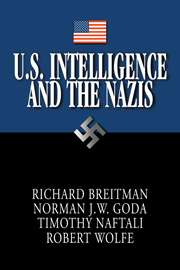Book contents
- Frontmatter
- Contents
- PREFACE
- Map 1
- Map 2
- U.S. INTELLIGENCE AND THE NAZIS
- INTRODUCTION
- SECTION ONE ESPIONAGE AND GENOCIDE
- SECTION TWO COLLABORATION AND COLLABORATORS
- SECTION THREE POSTWAR INTELLIGENCE USE OF WAR CRIMINALS
- 10 The Nazi Peddler: Wilhelm Höttl and Allied Intelligence
- 11 Tracking the Red Orchestra: Allied Intelligence, Soviet Spies, Nazi Criminals
- 12 Coddling a Nazi Turncoat
- 13 The CIA and Eichmann's Associates
- 14 Reinhard Gehlen and the United States
- 15 Manhunts: The Official Search for Notorious Nazis
- CONCLUSION
- APPENDIX: Western Communications Intelligence Systems and the Holocaust
- TERMS AND ACRONYMS
- SELECTED BIBLIOGRAPHY
- RECORD GROUPS CITED
- CONTRIBUTORS
- INDEX
11 - Tracking the Red Orchestra: Allied Intelligence, Soviet Spies, Nazi Criminals
Published online by Cambridge University Press: 25 February 2010
- Frontmatter
- Contents
- PREFACE
- Map 1
- Map 2
- U.S. INTELLIGENCE AND THE NAZIS
- INTRODUCTION
- SECTION ONE ESPIONAGE AND GENOCIDE
- SECTION TWO COLLABORATION AND COLLABORATORS
- SECTION THREE POSTWAR INTELLIGENCE USE OF WAR CRIMINALS
- 10 The Nazi Peddler: Wilhelm Höttl and Allied Intelligence
- 11 Tracking the Red Orchestra: Allied Intelligence, Soviet Spies, Nazi Criminals
- 12 Coddling a Nazi Turncoat
- 13 The CIA and Eichmann's Associates
- 14 Reinhard Gehlen and the United States
- 15 Manhunts: The Official Search for Notorious Nazis
- CONCLUSION
- APPENDIX: Western Communications Intelligence Systems and the Holocaust
- TERMS AND ACRONYMS
- SELECTED BIBLIOGRAPHY
- RECORD GROUPS CITED
- CONTRIBUTORS
- INDEX
Summary
Did the most renowned Soviet spy network in World War II, the Red Orchestra, offer vital clues to understanding Soviet espionage in the postwar period? The FBI, the U.S. Army Counterintelligence Corps (CIC), and the CIA, as well as British, French, and West German intelligence were all convinced that the answer was yes. Nazi Germany's Gestapo had gathered a great deal of information about the Red Orchestra, which put former Gestapo officials in the position of perceived experts who were ready to serve new masters in the postwar milieu. FBI, Army, and CIA documents newly declassified by the IWG reveal how a number of war criminals managed to get recruited by intelligence agencies and how they failed in their new capacity, for they never knew as much as they claimed to know about the Red Orchestra.
“Red Orchestra” (Rote Kapelle) was a Gestapo term describing Soviet espionage networks in Western Europe directed by Red Army Intelligence (Glavonoye Rasvodyvatelnoye Upravalenie, or GRU). In Berlin, the Soviets depended on information from well-placed officials in the German government. Harro Schulze-Boysen, the grand nephew of Grand Admiral Alfred von Tirpitz, headed one net from within the German Air Ministry. Arvid Harnack, the scion of a famous academic family and a senior official in the Reich Ministry of Economics, headed another net. Both networks were diverse collections of espionage amateurs—academics, artists, and writers united by leftist sympathies and antipathy to Nazism.
Professional Soviet agents ran the Western European networks.
- Type
- Chapter
- Information
- U.S. Intelligence and the Nazis , pp. 293 - 316Publisher: Cambridge University PressPrint publication year: 2005



